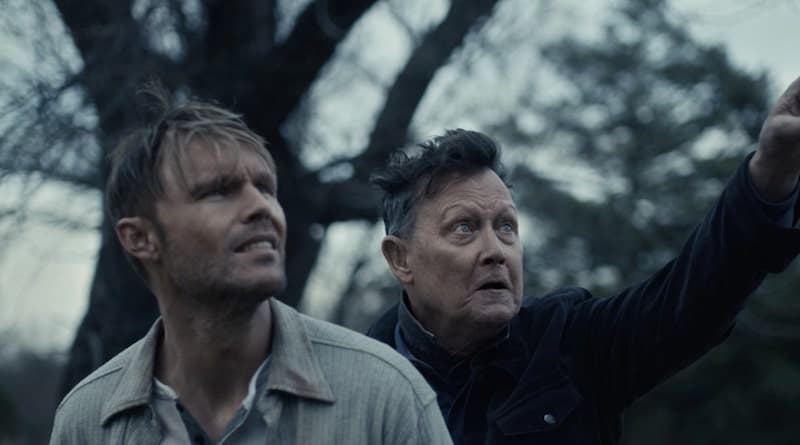‘What Josiah Saw’ Has One of the Best Horror Scores of the Year
Stolen gold, haunted land, and pitch-black family secrets: the Southern Gothic trifecta.

Derricks plumb the earth in search of subterranean riches. Not far off, the sun’s first rays fall on the rotting corpse of the Graham farm: a land with buried secrets of its own. The local lawman warns the prospective oil barons that the outlying Graham property is cursed. And it won’t be easy to convince what remains of the broken family to sell.
The Graham siblings’ relationship with their childhood home is complicated; bound up in a sticky web of bad memories they’d rather stay six feet under. Digging up the past can be a dangerous thing. And with the shadow of their abusive, alcoholic father (Robert Patrick) lurking in every doorframe, a devilish bargain with Devlin Oil threatens to tear open the siblings’ old wounds.
After premiering last summer at Fantasia, What Josiah Saw has found a home on Shudder. The film marks the third directorial effort of Vincent Grashaw, whose previous work demonstrates an interest in the darker strains of domestic drama — a thematic pressure point What Josiah Saw is keen to prod.
The film is split into chapters, each dedicated to a different sibling. We find Thomas (Scott Haze), the youngest, still haunting the soggy ruins of his family’s plot. While his father hurls abuses through a whiskey-powered haze, Thomas clings to his late mother’s faith. Then, one night, Josiah is seized with a vision we are not privy to. Whatever the nature of the visitation (supernatural, divine, or fabricated), something has come over him. Thomas must purify himself and the house. The eternal soul of his mother depends on it.
In the following chapters, we meet the now-grown twins, Eli (Nick Stahl) and Mary (Kelli Garner). The pair have since fallen into very different economic brackets. But, trailer or suburb, the aftershock of some unspecified trauma weighs heavily on their shoulders. Both clamor after a fresh start that they hope will wash away their sins. Eli seeks out cursed gold from a traveling Romani carnival. Mary hopes to adopt a child.
What Josiah Saw is not a horror anthology. But the chapter breaks and unifying bookends draw the comparison nevertheless. And like more international anthologies, certain chapters in What Josiah Saw are stronger than others. Mary’s section is a clear stand-out. Defined by its snappy pacing and the draw of her many mysteries. Least of all, why she has been sterilized.
In the end, all the pieces of the depraved puzzle fall into place. The final picture is pulpy and taboo-defying in the way all good Gothic Horror films should be. Whether the final blow is overkill will depend on your own limits for sleaze. Can a sandwich have too much mayonnaise? Can a horror film have too many stomach-churning third-act reveals? It’s a matter of taste.
At the risk of blaspheming (this is a Robert Patrick flick, after all), the real star of What Josiah Saw is Robert Pycior’s score. The film seems to know it too. The opening frames welcome us with wailing strings and vocal cacophony: a lament that oozes with a great debt to the soul-rattling Kyrie section of György Ligeti’s Requiem. It’s as though we’ve pressed our ears up against the gates of Hell itself. And the overall effect endows what is ultimately a domestic drama with a more traditionally “horrific” atmosphere.
It is an effective — if on the nose — touch to contrast a full-string chorus with the ominously quaint blips of bygone vinyl records. This is the film’s sonic thesis: religious guilt enmeshed with bootstrap Americana. In less than a minute, the score manages to wordlessly encapsulate What Josiah Saw’s whole deal. This clarity says a great deal about Pycior’s talents as a composer (we’ve heard him as a string player in The Rider and Swallow, but this film marks his first non-documentary feature-length effort). Unfortunately, where Pycior’s succinctness shines, the rest of the film feels overdrawn in comparison.
Any film with a two-hour runtime must justify its length. And to its credit, What Josiah Saw follows in the footsteps of other character-driven genre pictures, using those extra minutes with the Graham siblings to dig into the shared fault lines of their damage. But the bloat cannot be denied. A tighter, tenser cut of this film could exist that doesn’t sacrifice any of its atmospheric slow-burn. Enough parts of this film work that it’s a genuine shame that we keep sticking inquiring fingers in the same wounds over and over again.
What Josiah Saw also suffers from a noticeable degree of script-iness. Dialogue-driven, the film is often effortful and earnest in the way that first-time feature scripts tend to be. For the most part, these awkward soft spots tend to fold into the Southern Gothic penchant for melodrama. Some of these sweatier moments could have been cast aside in a dialogue-heavy film with fat to trim.
Shudder Originals are something of a mixed bag. And within the streaming service’s ever-expanding originals library, What Josiah Saw takes up residence somewhere in the middle, skewing toward some of the streamer’s better efforts. I think folks with generous attention spans who appreciate modern takes on the Southern Gothic genre will enjoy this one. But if you sit What Josiah Saw out, something tells me God will forgive you.
What Josiah Saw is now streaming exclusively on Shudder.
https://youtu.be/RJ8vKfzewuk